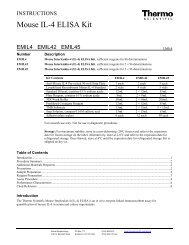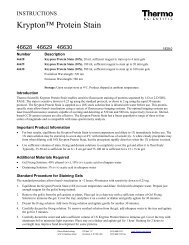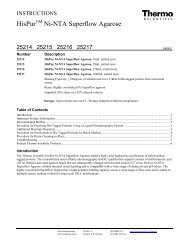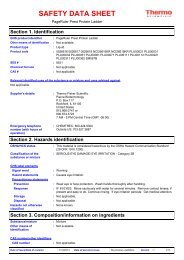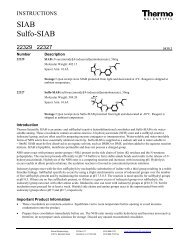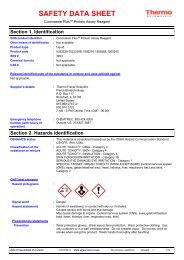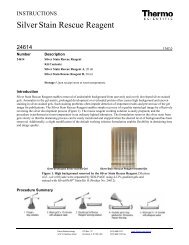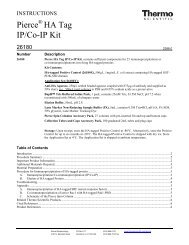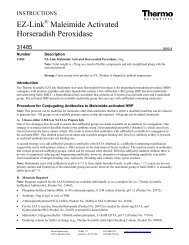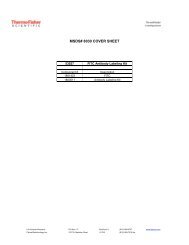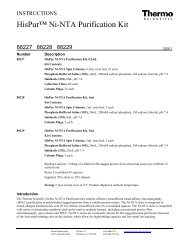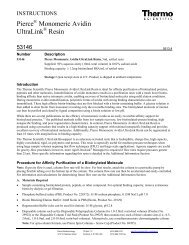Pierce Co-Immunoprecipitation (Co-IP) Kit
Pierce Co-Immunoprecipitation (Co-IP) Kit
Pierce Co-Immunoprecipitation (Co-IP) Kit
Create successful ePaper yourself
Turn your PDF publications into a flip-book with our unique Google optimized e-Paper software.
Important Product Information<br />
• Perform all resin centrifugation steps for 30-60 seconds at low speed (i.e., 1000-3000 × g). Centrifuging at speeds greater<br />
than 5000 × g may cause the resin to clump and make resuspension difficult.<br />
• When centrifuging spin columns, the flow-through volume should not exceed 600µL when using a 2mL collection tube<br />
and 300µL when using a 1.5mL collection tube. Exceeding these volumes can cause back pressure in the column and<br />
incomplete washing or elution.<br />
• Primary amines (e.g., Tris, glycine) in the antibody solution will compete for coupling sites on the resin. Remove<br />
primary amines before antibody immobilization using Thermo Scientific Zeba Spin Desalting <strong>Co</strong>lumns or Slide-A-Lyzer<br />
Dialysis Cassettes.<br />
• Gelatin or carrier proteins in the antibody solution will compete for coupling sites on the resin. Remove gelatin and<br />
carrier proteins using the Thermo Scientific <strong>Pierce</strong> Antibody Clean-up <strong>Kit</strong> (Product No. 44600) or by performing Protein<br />
A/G purification (Product No. 20423) and dialysis.<br />
• To reduce nonspecific protein binding in immunoprecipitations, pre-clear the lysate using the <strong>Co</strong>ntrol Agarose Resin or<br />
add Thermo Scientific Surfact-Amps X-100 (10% Triton ® X-100, Product No. 28314) to the Modified Dulbecco’s PBS<br />
at 0.1-1%. Note: Surfact-Amps ® X-100 is not supplied with the kit.<br />
• The <strong>IP</strong> Lysis/Wash Buffer has been tested on representative cell types including but not limited to the following cell<br />
lines: HeLa, Jurkat, A431, A549, MOPC, NIH 3T3 and U2OS. Typically, 10 6 HeLa cells yield ~10 mg of cell pellet and<br />
~3µg/µL (or 300µg) when lysed with 100µL of <strong>IP</strong> Lysis/Wash Buffer.<br />
• For best results, add Thermo Scientific Halt Protease (Product No. 78430) and Phosphatase (Product No. 78428)<br />
Inhibitor <strong>Co</strong>cktails to minimize degradation and dephosphorylation of cell lysate proteins. These inhibitors are also<br />
available as a combined cocktail (Product No. 78440). See the Related Thermo Scientific Products Section for more<br />
information.<br />
• The <strong>IP</strong> Lysis/Wash Buffer and Elution Buffer are compatible with the Thermo Scientific <strong>Pierce</strong> BCA Protein Assay<br />
(Product No. 23225).<br />
• Proper controls are vital for identifying relevant interactions. The supplied <strong>Pierce</strong> <strong>Co</strong>ntrol Agarose Resin is composed of<br />
the same support material as the AminoLink Plus <strong>Co</strong>upling Resin but is not amine-reactive. This resin provides an<br />
excellent negative control.<br />
• The <strong>Pierce</strong> Spin <strong>Co</strong>lumns package includes columns, screw caps, plugs, Luer-Lok ® Adapter Caps, large frits and a large<br />
frit tool. The large frit is not needed for the standard <strong>IP</strong> protocol. When scaling-up the <strong>IP</strong> reaction (i.e., > 200µL of<br />
resin), the large frit can be inserted to facilitate washing. The Luer-Lok Caps have a flip top that may be used during<br />
wash steps. Use the screw caps for sealing the spin columns during storage. (See the Additional Information Section.)<br />
• The <strong>Pierce</strong> <strong>Co</strong>-<strong>Immunoprecipitation</strong> <strong>Kit</strong> can be scaled as needed. For optimal results, perform co-<strong>IP</strong> reactions with resin,<br />
antibody, elution and wash quantities indicated in Table 1. These conditions result in a coupling efficiency of ~95% after<br />
2 hours. <strong>Co</strong>upling efficiency can be approximated by measuring the absorbance of the antibody solution at 280nm before<br />
and after coupling.<br />
Table 1. Amounts of antibody, coupling resin, wash buffer and elution buffer to use.<br />
Additional Material Required<br />
<strong>Co</strong>upling Resin<br />
Volume (µL)<br />
Antibody<br />
Wash<br />
Amount (µg) (volume of 50% slurry) Volume (µL)<br />
250-1000 100 (200) 400 100-150<br />
75-250 50 (100) 300 75-100<br />
10-75 25 (50) 200 50-75<br />
≤ 10 10 (20) 200 50<br />
• Microcentrifuge collection tubes, 2mL<br />
<strong>Pierce</strong> Biotechnology PO Box 117 (815) 968-0747 www.thermoscientific.com/pierce<br />
3747 N. Meridian Road Rockford, lL 61105 USA (815) 968-7316 fax<br />
2<br />
Elution Buffer<br />
Volume (µL)



